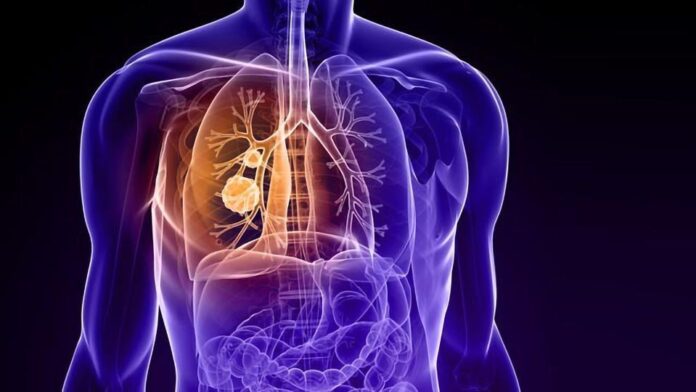By Dr. Kapil Uttamrao Raut, MBBS, MD Medicine, DM Medical oncology, ECMO (UK) , Medical Oncology, HCG NCHRI Cancer Centre, Nagpur
Lung cancer, a devastating disease that affects millions worldwide, is primarily caused by prolonged exposure to harmful substances. Smoking is the most significant risk factor, accounting for the majority of lung cancer cases. The carcinogens present in tobacco smoke damage the cells lining the lungs, leading to the development of cancerous tumors over time. However, non-smokers can also develop lung cancer due to exposure to secondhand smoke, air pollution, radon gas, asbestos, and other occupational hazards like certain chemicals and minerals.
The symptoms of lung cancer often manifest in the later stages of the disease, which makes early detection challenging. Common symptoms include persistent cough, chest pain, shortness of breath, wheezing, unexplained weight loss, fatigue, and recurring respiratory infections. Sometimes, lung cancer may cause symptoms outside the respiratory system, such as bone pain, headaches, and neurological issues if the cancer has spread to other parts of the body.
Diagnosing lung cancer typically involves a combination of imaging tests, such as chest X-rays and CT scans, and tissue sampling through biopsies. The biopsy allows doctors to analyze the cells for cancerous growth and determine the cancer type and stage. Additionally, other tests, like bronchoscopy, PET scans, and genetic testing, may be conducted to provide more information about the extent of the disease. The prognosis for lung cancer varies depending on the cancer type, stage at diagnosis, and the patient’s overall health. Early detection significantly improves the chances of successful treatment and long-term survival. However, many cases are diagnosed in advanced stages, making treatment more challenging. Advances in medical technology, personalized therapies, and targeted treatments have shown promising results, offering hope for improved outcomes for patients with lung cancer.
Here we are exploring exciting new possibilities in lung cancer, there diagnosis and prognosis – the realm of emerging biomarkers. These biomarkers hold the potential to transform lung cancer management, offering early detection, personalized treatment approaches, and better outcomes for patients.
The Need for Emerging Biomarkers
Conventional diagnostic methods for lung cancer, such as imaging and tissue biopsies, have been useful but not without limitations. Imaging techniques can spot lung nodules, but they might not always be accurate, leading to false positives and unnecessary invasive procedures. Tissue biopsies, while reliable, can be challenging to obtain, especially in advanced cases or when the tumor is hard to reach. However, there’s hope on the horizon with emerging biomarkers. These are measurable molecular indicators found in body fluids or tissues that reveal the presence or progression of cancer. Ongoing research has uncovered some promising biomarkers that offer a less invasive and more accurate alternative to traditional diagnostic approaches.
The Promise of Liquid Biopsies
A revolutionary tool in cancer detection and monitoring is liquid biopsies. By analyzing circulating tumor components in blood or other body fluids, liquid biopsies can provide real-time information on cancer status, allowing for early detection and monitoring of treatment response. One of the most promising types of emerging biomarkers for lung cancer is circulating tumor DNA (ctDNA). When cancer cells die, they release DNA into the bloodstream, and ctDNA can be detected and analyzed to identify specific genetic changes associated with lung cancer. This approach has shown encouraging results in detecting early-stage lung cancer and tracking treatment response, allowing doctors to adjust therapies as needed.
MicroRNAs – Small but Powerful Indicators
MicroRNAs (miRNAs) are tiny RNA molecules that play a crucial role in regulating gene expression. They have been linked to various diseases, including cancer. In lung cancer, specific miRNAs have shown potential as diagnostic and prognostic biomarkers.
Researchers have identified miRNA signatures associated with different lung cancer subtypes and stages. These miRNA profiles could be used to create more accurate and personalized diagnostic tools. Furthermore, miRNAs might serve as indicators of treatment response and disease progression, helping doctors tailor therapies for individual patients to achieve better outcomes.
The Immune System and Immunotherapy Biomarkers
Immunotherapy has transformed cancer treatment, and lung cancer has benefited from these advances. However, not all patients respond equally to immunotherapy, emphasizing the need for predictive biomarkers that can identify likely responders.
Several emerging biomarkers are being studied for their potential to predict immunotherapy response. Tumor-infiltrating lymphocytes (TILs) and programmed death-ligand 1 (PD-L1) expression have shown promise in guiding treatment decisions. Additionally, the tumor mutational burden (TMB) – the number of mutations in a tumor’s DNA – has emerged as a potential predictor of immunotherapy response. These biomarkers could help identify patients who are most likely to benefit from immunotherapy, sparing others from potential side effects and enabling alternative treatment strategies.
Path Ahead
The future of lung cancer management lies in harnessing the potential of emerging biomarkers. With ongoing research, collaboration between scientists, and advancements in technology, we are moving closer to a new era of personalized lung cancer care. Early detection through liquid biopsies, tailored treatments based on miRNA signatures, and improved immunotherapy selection could soon become a reality, offering new hope to patients and their families in the fight against lung cancer.






















